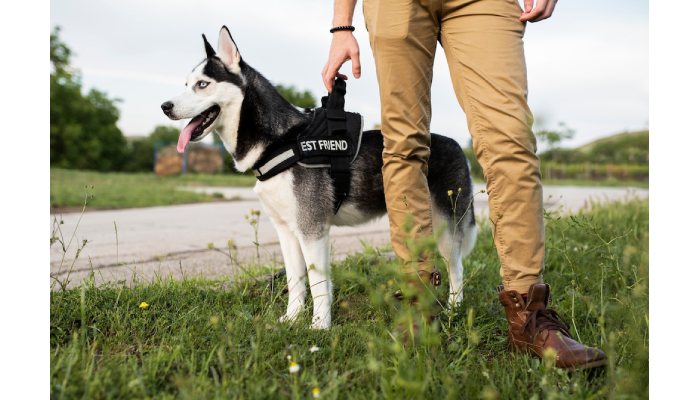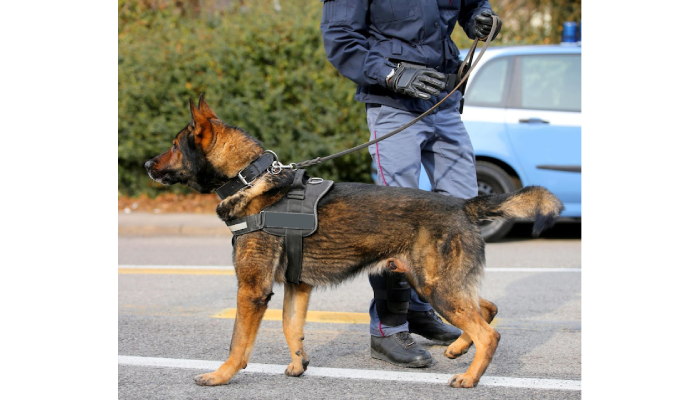
Preparing for a police K9 expert witness testimony involves several key steps that are essential for demonstrating credibility. Start by establishing your expertise; ensure your experience in handling the K9 is well-documented, along with a log of successful tracking instances. Next, prepare thorough documentation like a resume highlighting training and relevant courses. It’s also important to review recordings related to the incident and practice responses alongside prosecutors to build confidence. Understanding court procedures will help you navigate direct and cross-examinations smoothly. Maintain professionalism throughout, providing clear, objective answers while utilizing visual aids to enhance comprehension during your testimony.
1. Establishing Your Expertise as a K9 Handler
As a K9 handler, establishing your expertise is crucial for your role as an expert witness. Begin by detailing your specific training in K9 handling and the types of dogs you’ve worked with, whether they are German Shepherds, Belgian Malinois, or other breeds. Highlight any certifications or specialized training programs you have completed, especially those recognized in law enforcement, such as narcotics detection or tracking. This showcases your credibility.
Ongoing education is also important. Mention any recent courses or workshops you’ve attended that focus on modern K9 training methods. If you possess specialized skills, like search and rescue or tracking, make sure to emphasize these as they underline your capabilities.
If you’ve published articles or papers on K9 handling, include them as evidence of your knowledge. Your experience in various environments, from urban settings to rural landscapes, can significantly influence police K9 expert witness performance, so sharing insights from these experiences can strengthen your testimony.
Gather testimonials from colleagues or supervisors that affirm your expertise. These endorsements can provide an additional layer of trustworthiness to your claims. It’s also beneficial to outline your experience with cases that involved K9 evidence, detailing the outcomes to demonstrate the impact of K9 contributions in law enforcement.

2. Preparing Essential Documentation for Court
To effectively prepare for your role as a K9 expert witness, meticulous documentation is crucial. Start by gathering all relevant training certificates for both you and your K9 partner. This includes certifications that validate your expertise and the dog’s specialized training. Next, compile a detailed log of all deployments and specific cases where the K9 was involved. This log should highlight the circumstances of each case, the K9’s contributions, and the outcomes, showcasing the dog’s reliability and effectiveness.
Creating a checklist of necessary documents can help ensure you don’t forget anything on the day of your testimony. This list should include your resume, training records, case logs, and any reports or analyses from previous cases that might be referenced during your testimony. Additionally, prepare a summary of key incidents that illustrate the K9’s abilities, focusing on specific examples that demonstrate its skills in action.
Organizing all documentation chronologically will make it easier to reference during your testimony. Use clear language throughout your documents, avoiding jargon to ensure that everyone in the courtroom can understand your points. Make sure all your documents meet the legal requirements for expert witnesses in your jurisdiction, as this helps establish your credibility.
Including a glossary of terms that might be used during your testimony can also aid comprehension, especially for those unfamiliar with K9 operations. Finally, prepare multiple copies of all documents for the prosecution, defense, and court clerk to facilitate a smooth process on the day of your appearance.
3. Reviewing and Practicing Key Testimony Points
List out the main points you want to cover in your testimony. Focus on the K9’s training, performance, and specific incidents that demonstrate its capabilities. Once you’ve outlined these points, practice delivering your testimony aloud. Doing this in front of a peer or mentor can help you gain valuable feedback and confidence.
Anticipate the questions you might face during your testimony. Prepare clear and concise responses to these inquiries, ensuring they reflect your expertise. Role-playing cross-examination scenarios with a colleague can also be a helpful exercise, as it builds your confidence and readiness for unexpected challenges.
While practicing, concentrate on maintaining a calm demeanor. This composure will be crucial when you take the stand. Reviewing previous court cases involving K9 testimony can provide insights into common themes and frequently asked questions, further enhancing your preparedness.
4. Understanding Court Procedures for Testimony
Before stepping into the courtroom, it’s essential to grasp the specific rules and procedures that govern expert witnesses. Each court may have its own set of guidelines, so familiarizing yourself with these is crucial. Understand the courtroom dynamics—who speaks when, how to properly address the judge, and when to stand or sit. Knowing the difference between direct examination, where you present your expertise, and cross-examination, where opposing counsel questions you, is vital for navigating the testimony process effectively.
Recognize the roles of key players: the prosecutor presents the case, the defense attorney challenges it, and the judge oversees the proceedings. Maintaining objectivity and neutrality in your testimony is important for credibility. Courtroom etiquette matters too—dress professionally and conduct yourself with respect. Be prepared for objections from attorneys; knowing how to respond calmly and clearly can make a significant difference.
Understand that your testimony may be time-limited, so practicing concise and relevant answers is beneficial. If any legal terms or protocols confuse you, clarify them beforehand. This preparation not only boosts your confidence but also enhances the overall effectiveness of your testimony.
5. Effective Presentation Techniques in Court
To effectively present your testimony as a Police K9 expert witness, start by developing a clear outline of your presentation. This will guide you through your points and keep you organized. Use simple, direct language that everyone in the courtroom can understand. It’s crucial to make eye contact with the judge and jury to engage them, showing confidence in your expertise.
Be mindful of your body language; standing tall and avoiding crossed arms can convey professionalism. If allowed, visual aids like charts or images can help illustrate your key points, making complex information easier to digest. Always summarize intricate details into digestible parts, and explain any technical terms right away to ensure clarity.
Prepare a strong opening statement that outlines your qualifications and the purpose of your testimony. This sets the stage for what’s to come. Additionally, practice responding to questions succinctly, focusing on the topic to maintain clarity. Finally, conclude with a concise summary of your testimony to reinforce the key points you want the court to remember.
6. Conducting Yourself Professionally During Testimony
Arriving early at the courthouse is crucial to set the right tone for your testimony. This allows you to settle in and avoid the stress of rushing through security or locating the courtroom. Dressing in formal attire not only demonstrates professionalism but also conveys respect for the court, which can positively influence how you are perceived. During your testimony, maintain a respectful tone when addressing the judge and attorneys. It’s essential to stay composed, especially during cross-examination; showing frustration or annoyance can undermine your credibility. Listen carefully to each question before responding to ensure that your answers are clear and accurate. If you feel provoked by challenging questions, remain calm and collected. Using ‘I’ statements can help take ownership of your observations and conclusions, making your testimony more relatable and credible. Stick to the facts based on your experience and knowledge, avoiding speculation at all costs. If there seems to be any confusion from the judge or attorneys, be prepared to clarify your points. Finally, express gratitude to the court for their time and attention once your testimony concludes, leaving a positive impression.
7. Handling Cross-Examination with Confidence
Cross-examination can be challenging, but with the right preparation, you can handle it with confidence. Start by anticipating aggressive questioning. Practice your responses to remain calm, even under pressure. Rehearsing answers to common strategies that defense attorneys might use will help you feel more prepared. During cross-examination, it’s crucial to focus on the question being asked. Avoid the temptation to provide extra information, as this can lead to confusion or misinterpretation. If you’re unsure about an answer, it’s perfectly acceptable to admit it rather than guessing. This honesty can enhance your credibility.
Maintain a polite and composed demeanor, even if the attorney becomes confrontational. Remember, arguing will not benefit your position. Take your time when responding; rushing can lead to mistakes. Clear, concise answers are easier for the judge and jury to understand. If an objection arises, pause and wait for the judge’s instructions before proceeding. Keeping your emotions in check is vital; a calm demeanor can strengthen your position as a credible witness. Ultimately, your goal is to present factual information, not to win an argument.
8. Collaborating with Prosecutors for Success
Collaboration with the prosecutor is vital for a successful testimony. Schedule regular meetings to align on case strategies. During these discussions, share details about the K9’s training and capabilities to help the prosecutor understand the evidence more deeply. It’s also important to address potential weaknesses in your testimony; this way, you can devise strategies to counter them effectively. Be open to feedback regarding your presentation style, as the prosecutor may offer insights that enhance clarity and impact. Keep them updated on any changes in your K9’s training or performance, ensuring that they have the latest information to present the strongest case possible. Review the prosecution’s approach to ensure your testimony complements their case without causing discrepancies. Clarify any legal terms or case facts that may need further explanation during the trial, making sure both you and the prosecutor are on the same page. Discuss the best ways to present evidence related to the K9’s actions during the incident, as a well-coordinated presentation can significantly influence the jury’s perception. Being proactive in communicating any new developments in ongoing investigations is equally crucial. Lastly, collaborate on strategies to address potential defenses that may arise during the trial, ensuring you are prepared to support the case effectively.
9. Reflecting on Your Testimony Performance
Immediately after your testimony, jot down notes about what went well and areas where you can improve. This reflection is crucial for your development. Seek feedback from the prosecutor regarding your delivery and clarity. Understanding how your testimony was received can provide valuable insights. If allowed, consider recording your testimony for later review, which will help you self-assess your performance more thoroughly.
Engage in discussions with colleagues or mentors about your experience. Getting different perspectives can open your eyes to aspects you might not have considered. Identify any unexpected questions during your testimony; these moments can highlight gaps in your preparation that you can address for next time.
Think about how you managed your composure during cross-examination. Maintaining a calm demeanor is essential, as it can affect how the jury perceives your credibility. Evaluate your use of visual aids—did they enhance understanding, or were they distracting? Reflect on any points where you could have communicated more effectively. Lastly, consider the impact of your testimony on the jury’s perception of the evidence presented. Set specific goals for your next appearance based on your reflections; continuous improvement is key to becoming a successful expert witness.
10. Ethical Considerations for Expert Witnesses
It is crucial for expert witnesses to adhere to a strict code of ethics in their jurisdiction. This includes ensuring that your testimony is grounded in scientifically accepted practices rather than personal beliefs. For instance, exaggerating the capabilities of a K9 or your expertise can undermine your credibility. Additionally, maintaining confidentiality about case details and sensitive information is essential. Be honest about the limitations of K9 capabilities; for example, while a K9 may excel in tracking, they are not infallible. Personal biases should never influence your testimony. Continuous education is vital to keep you updated on ethical guidelines and best practices, helping you navigate any potential conflicts of interest that may arise. Documenting all communications related to the case promotes transparency, reinforcing the integrity of the legal process. Ultimately, your goal should always be to uphold justice through your testimony.